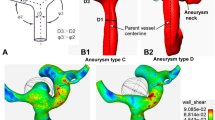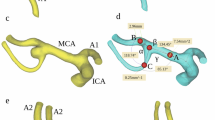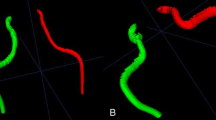Summary
In order to investigate the developmental mechanism of cerebral aneurysms, the in vivo flow pattern around human cervical carotid bifurcations was studied by flow visualization using digital subtraction angiography with an isotonic contrast medium.
The blood stream containing the medium impinged on the apex, then proceeded along the walls of the branches. After opacification of the whole lumen around the apex, most of the medium was carried away, while some remained for a few seconds at the carotid sinus. In the internal carotid artery, the blood struck the wall at an oblique angle near the tops of the arterial curvatures. In cases with atheromatous plaque or kinking of the branch, the blood passed through the stenosed segment and moved upstream, indicating turbulence.
The study suggests that haemodynamic forces around the apex consist mainly of impingement on the apex and shear stress to the wall at and around the apex. In branches, high shear stress seems to exist. It might be possible that high shear stress causes degenerative changes in the endothelial layer, initiating the formation of saccular and fusiform cerebral aneurysms.
Similar content being viewed by others
References
Anderson DC, Fischer GG (1985) Impact of digital subtraction angiography on carotid evaluation. Stroke 16: 23–28
Bharadvaj BK, Mabon RF, Giddens DP (1982) Steady flow in a model of the human carotid bifurcation. Part 1. Flow visualization. J Biomech 15: 349–362
Duff TA, Turski PA, Sackett JF, Strother CM, Crummy AB (1982) Evolving role of digital subtraction angiography in neurosurgical practice. Neurosurgery 11: 430–438
Ferguson GG (1972) Physical factors in the initiation, growth, and rupture of human intracranial saccular aneurysms. J Neurosurg 37: 666–677
Ferguson GG (1970) Turbulence in human intracranial saccular aneurysms. J Neurosurg 33: 485–497
Forbus WD (1930) On the origin of miliary aneurysms of the superficial cerebral arteries. Bull Johns Hopkins Hosp 47: 239–284
Fry DL (1968) Acute vascular endothelial changes associated with increased blood velocity gradients. Circ Res 22: 165–197
Gessner FB (1973) Hemodynamic theories of atherogenesis. Circ Res 3: 259–266
Hashimoto N, Handa H, Hazama F (1978) Experimentally induced cerebral aneurysms in rats. Surg Neurol 10: 3–8
Hashimoto N, Handa H, Nagata I, Hazama F (1980) Experimentally induced cerebral aneurysms in rats. Part V: Relation of hemodynamics in the circle of Willis to formation of aneurysms. Surg Neurol 13: 41–45
Hassler O (1961) Morphological studies on the large cerebral arteries. With reference to the aetiology of subarachnoid haemorrhage. Acta Psychiatr Neurol Scand [Suppl] 36: 1–145
Hazama F, Amano S, Haebara H, Yamori Y, Okamoto K (1976) Pathology and pathogenesis of cerebrovascular lesions in Spontaneous hypertensive rats. In: Cervós-Navarro J, Matakas F (eds) The cerebral vessel wall. New York, Raven Press, pp 245–252
Hazama F, Hashimoto N (1987) Annotation. An animal model of cerebral aneurysms. Neuropathol Appl Neurobiol 13: 77–90
Hazama F, Kataoka H, Yamada E, Kayembe K, Hashimoto N, Kojima M, Kim Ch (1986) Early changes of experimentally induced cerebral aneurysms in rats. Light-microscopic study. Am J Pathol 124: 399–404
Kayembe KT, Sasahara M, Hazama F (1984) Cerebral aneurysms and variations in the circle of Willis. Stroke 15: 846–850
Kim Ch, Kikuchi H, Hashimoto N, Hazama F (1990) Angiographic study of induced cerebral aneurysms in primates. Neurosurgery 27: 715–720
Kim Ch, Kikuchi H, Hashimoto N, Hazama F (1989) Histopathological study of induced cerebral aneurysms in primates. Surg Neurol 32: 45–50
Kim Ch, Kikuchi H, Hashimoto N, Hazama F, Kataoka H (1989) Establishment of the experimental conditions for inducing saccular cerebral aneurysms in primates with special reference to hypertension. Acta Neurochir (Wien) 96: 132–136
Kim Ch, Kikuchi H, Hashimoto N, Kojima M, Kang Y, Hazama F (1988) Involvement of internal elastic lamina in development of induced cerebral aneurysms in rats. Stroke 19: 507–511
Kojima M, Handa H, Hashimoto N, Kim Ch, Hazama F (1986) Early changes of experimentally induced cerebral aneurysms in rats: Scanning electron microscopic study. Stroke 17: 835–841
Ku DN, Giddens DP (1983) Pulsatile flow in a model carotid bifurcation. Arteriosclerosis 3: 31–39
Liepsch DW, Steiger HJ, Poll A, Reulen HJ (1987) Hemodynamic stress in lateral saccular aneurysms. Biorheology 24: 689–710
LoGerfo FW, Nowak MD, Quist WC (1985) Structural details of boundary layer separation in a model human carotid bifurcation under steady and pulsatile flow conditions. J Vasc Surg 2: 263–269
Ludwig JW, Verhoeven LHJ, Engels PHC (1982) Digital video subtraction angiography (DSA) equipment. Angiographic technique in comparison with conventional angiography in different vascular areas. Br J Radiol 55: 545–553
Matsuda I, Niimi H, Moritake K, Okumura A, Handa H (1978) The role of hemodynamic factors in arterial wall thickening in the rat. Atherosclerosis 29: 363–371
Micholls SC, Phillips DJ, Primozich JF, Lawrence RL, Kohler TR, Rudd TG, Strandness DE (1989) Diagnostic significance of flow separation in the carotid bulb. Stroke 20: 175–182
Motomiya M, Karino T (1984) Flow patterns in the human carotid artery bifurcation. Stroke 15: 50–56
Nakatani H, Hashimoto N, Kang Y, Yamazoe N, Kikuchi H, Yamaguchi S, Niimi H (1991) Flow patterns at major bifurcations and cerebral aneurysms in rats. J Neurosurg 74: 258–262
Robinson JL, Roberts A (1972) Operative treatment of aneurysms and Coanda effect: a working hypothesis. J Neurol Neurosurg Psychiatry 35: 804–809
Seeger J, Weinstein PR, Carmony RF, Ovitt TW, Fisher HD, Capp MP (1982) Digital video subtraction angiography of the cervical and cerebral vasculature. J Neurosurg 56: 173–179
Sekhar LN, Heros RC (1981) Origin, growth, and rupture of saccular aneurysms: A review. Neurosurgery 8: 246–260
Steiger HJ, Reulen H-J (1986) Low frequency flow fluctuations in saccular aneurysms. Acta Neurochir (Wien) 83: 131–137
Steiger HJ, Pöll A, Liepsch D, Reulen H-J (1987) Haemodynamic stress in lateral saccular aneurysms. Acta Neurochir (Wien) 86: 98–105
Steiger HJ, Aaslid R, Reulen H-J (1989) Growth of aneurysms can be understood as passive yield to blood pressure. An experimental study. Acta Neurochir (Wien) 100: 74–78
Wolinsky H, Goldfischer S, Schiller B, Kasak LE (1974) Modification of the effects of hypertension on lysosomes and connective tissue in the rat aorta. Circ Res 34: 233–241
Wright HP (1968) Endothelial mitosis around aortic branches in normal guinea pigs. Nature 220: 78–79
Yaşargil MD (1987) Pathological conditions. In: Yaşargil MD (ed) Microneurosurgery, Vol 1. Thieme Medical Publishers, New York, pp 279–349
Zarins CK, Giddens DP, Bharadvaj BK, Sottiurai VS, Mabon RF, Glagov S (1983) Carotid bifurcation atherosclerosis. Quantitative correlation of plaque localization with flow velocity profiles and wall shear stress. Circ Res 53: 502–514
Author information
Authors and Affiliations
Additional information
Supported by grant from the Alexander von Humboldt Foundation.
Rights and permissions
About this article
Cite this article
Kim, C., Cervós-Navarro, J., Pätzold, C. et al. In vivo study of flow pattern at human carotid bifurcation with regard to aneurysm development. Acta neurochir 115, 112–117 (1992). https://doi.org/10.1007/BF01406368
Issue Date:
DOI: https://doi.org/10.1007/BF01406368




